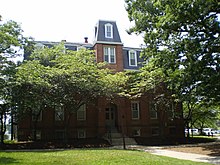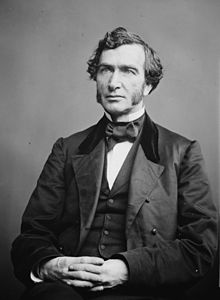Morrill Laws
The Morrill Laws (Eng .: Morrill Land-Grant Acts ) are laws of the United States that ensured that agricultural colleges could be established. These include the Morrill Act of 1862 ( USC Title 7 §301 et seq.) And the Morrill Act of 1890 (the Agriculture College Act of 1890, (US Statute 26 §417, USC Title 7 §321 et seq.))
Approval of the original bill
20 years before the law was first drafted, there was a political movement calling for the creation of agricultural colleges. The movement was led by Professor Jonathan Baldwin Turner of Illinois College . On February 8, 1853, the Illinois legislature passed a resolution drafted by Turner calling on the Illinois congressional delegation to draft a land-grant bill to fund a system of colleges; one in each state. Illinois Senator Lyman Trumbull felt that this would best be brought in by a congressman from an eastern state. That is why the bill was proposed two months later by Vermont's Justin Smith Morrill .
Unlike the Turner Plan, which would give each state an equal grant, the size of the grant under Morrill's Act was dependent on the number of senators and congressmen in the state. This gave the eastern states an advantage because of their larger populations.
The Morrill Act was first proposed in 1857 and passed by Congress in 1859. But it was prevented by veto by President James Buchanan . In 1861, Morrill again brought the law before Congress, with the change that the designated schools should teach military tactics in addition to technology and agriculture. As a result of the resignation of many states that do not support the plan, this amended Morrill bill could be passed and was signed by President Abraham Lincoln on July 2, 1862.
Land-grant colleges

The aim of the land grant universities of applied sciences was:
... without excluding other scientific and classical studies, and with military tactics to teach subjects related to agriculture and the mechanical arts, as prescribed by the legislators of the states, so that the liberal and practical training of the working classes be promoted in the various occupations and professions of life.
The law gave each eligible state 30,000 acres of state, either inside or outside its borders, for each Congressman the state had at the time of the 1860 census. This land, or the proceeds from its sale, should be used to support and finance these schools. According to the law, no state that rebelled against the United States government could benefit from this law. This provision was related to the secession of many southern states from the federal government and to the civil war . After the war, however, the law of 1862 was extended to the former confederate states; it ultimately covered every state and territory, including those that emerged after 1862. If the federal territory in one state was not able to meet its grant, a so-called "scrip" was assigned to the state, which gave it the right to select states in other states in order to finance schools. New York , for example, carefully examined valuable timber land in Wisconsin out to the Cornell University to establish. p.9 Although New York received only one-tenth of the 1862 grant, the administration of this scrip brought one-third of the total grant income to all states. P.10 Taken together, the 1862 Morrill Act distributed 70,000 km² of land that raised $ 7.55 million in sales. p.8
On September 11, 1862, Iowa became the first state to accept the terms of the law. This created the funds to establish the new state agricultural college and model farm (later known as the Iowa State University of Science and Technology).
With a few exceptions (such as Cornell University and Massachusetts Institute of Technology ), almost all land grant schools are public. (Although Cornell University is private, it runs several statutory schools that serve their public mission to New York.)
In order to retain their status as land grant schools, certain programs must be offered by the schools. Among these are Agriculture , Engineering and also Reserve Officer Training Corps .
Spread

A second Morrill Act of 1890 targeted the former Confederate States . This law required each state to prove that the breed was either not an admission criterion or that a separate land grant school was established for colored people. Among the 70 colleges and colleges ultimately created by the Morrill Acts, many are Historic African American colleges and colleges . Although the law of 1890 allocated money instead of land, colleges founded under it had the same legal status as those of 1862: they are therefore all to be described under the term "land-grant school".
Colleges such as the University of the District of Columbia were later established for the Indians of North America . These so-called "1994 land-grant colleges" were also founded by the Congress with money instead of land.
Similar to the land grant colleges specializing in agriculture and technology, the Congress later also established sea grant colleges (for water research, 1966), urban grant colleges (for urban research, 1985), space grant colleges (for space research, 1988), and sun grant colleges (sustainable energy research, 2003).
Agricultural research stations and cooperative support services
In early 1887, Congress also funded agricultural research stations and various categories of agricultural and veterinary research "under the direction" of agricultural schools. The Congress later recognized the need to pass the knowledge that had been acquired in the agricultural schools on to farmers and landlords. The Smith-Lever Act of 1914 provided federal funds for cooperative support services so that representatives from agricultural schools could be sent to almost every county . In some states, grants to schools under these laws exceed the current income of the original grants. The USDA fiscal 2006 budget allocated $ 1,033 billion for research and collaborative support services nationwide. To this end, then-President Bush proposed a sum of $ 1,035 billion for the 2008 fiscal year.
Individual evidence
- ^ Letter from Lyman Trumbull to JB Turner, October 19, 1857.
- ^ Carl L. Becker : Cornell University Founders and The Founding. Cornell University Press, 1943, pp. 28-30.
- ↑ USC Title 7 §304
- ↑ USC Title 7 §302
- ↑ a b c A Land-Grant University. Cornell.edu, archived from the original on February 28, 2008 ; Retrieved February 12, 2013 .
- ^ History of Iowa State: Time Line, 1858–1874. Iowa State University, 2006, archived from the original on May 3, 2013 ; Retrieved July 9, 2009 .
- ↑ USC Title 7 §323
- ↑ USC Title 7 §361a
- ↑ USDA Budget Summary 2006 - Research, Education, and Economics ( Memento of April 3, 2005 in the Internet Archive )
- ↑ CSREES FY2008 President's Budget Proposal. (PDF) Archived from the original on February 17, 2012 ; Retrieved February 12, 2013 .

